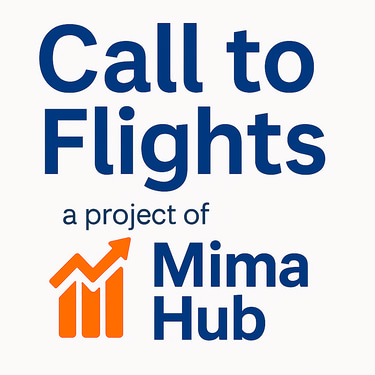Google Ads vs. Social Media: Which Drives Better Calls for Flights?
ADS & CREATIVES – SEO PROMPTS
9/24/20257 min read


Introduction
The digital marketing landscape has evolved significantly, presenting various platforms for businesses, especially in the travel sector, to engage with potential customers. Among these platforms, Google Ads and social media stand out as pivotal channels for driving engagement and generating leads. This blog post will explore the effectiveness of these marketing strategies, focusing on their ability to stimulate calls for flight bookings.
In the current age of technology, travelers are increasingly reliant on online resources to plan their journeys. As such, businesses in the travel industry must adopt effective advertising strategies to not only capture the attention of potential customers but also convert them into bookings. The choice of advertising platform can greatly influence the success of these marketing campaigns.
Google Ads offers targeted advertising options that capture users actively searching for flights. This intent-driven approach ensures that ads reach audiences ready to make decisions, thereby enhancing the likelihood of generating calls for bookings. Conversely, social media serves as a valuable tool for building brand awareness and community engagement, enabling travel companies to showcase destinations, flight deals, and unique experiences in a more visually appealing manner.
Understanding the nuances of these platforms is crucial for travel companies seeking to optimize their marketing efforts. While Google Ads helps in targeting direct searches, social media facilitates a broader engagement strategy that can lead to conversions over time. This interplay between immediate intent and long-term brand loyalty is pivotal for businesses aiming to thrive in an increasingly competitive travel market.
Ultimately, both Google Ads and social media possess unique advantages that can substantially impact call generation for flight bookings. The effectiveness of each platform can vary based on the target audience, campaign objectives, and overall marketing strategy employed. In the sections that follow, we will delve deeper into the comparative benefits of these advertising channels for the travel industry.
Understanding Google Ads for Flights
Google Ads is an advertising platform that allows businesses to promote their services to a targeted audience effectively. For airlines and travel agencies, leveraging Google Ads to promote flights can significantly enhance visibility and drive traffic to their booking platforms. The model primarily operates on a pay-per-click (PPC) basis, enabling advertisers to pay only when users click on their ads. This makes it a cost-effective solution for marketing flight options, as it directly relates spending to user engagement.
One of the critical advantages of Google Ads is its robust targeting options. Advertisers can specify demographics, geographic locations, interests, and even contextual targeting based on search terms. For example, an airline might particularly benefit from targeting customers who have recently searched for "flights to New York" or "cheap flights in December." By utilizing these targeting features, the ads can connect with potential customers actively seeking flight options, thus maximizing the chances of conversions and bookings.
In addition to ensuring precise audience targeting, the proper use of keywords is essential within Google Ads campaigns for flights. Incorporating relevant keywords such as "Google Ads flights," "cheap flights," or "last-minute flights" can help tailor ad messages, improving the likelihood of attracting interested buyers. Furthermore, optimized ad copy and landing pages improve the quality score, which can lower the cost per click and enhance the ad's position. Continuous monitoring and adjusting of campaigns based on performance analytics fosters ongoing improvement, ensuring the ad remains relevant. Ultimately, effective use of Google Ads can not only increase visibility but also significantly drive qualified traffic to booking platforms, leading to increased call volumes for flight inquiries and reservations.
Leveraging Social Media for Flight Bookings
Social media has become an indispensable tool for travel businesses aiming to enhance their visibility and engagement with potential customers. Platforms such as Facebook, Instagram, and Twitter offer unique functionalities that can be effectively harnessed to drive calls for flight bookings. Each of these channels presents opportunities for direct interaction with users, allowing travel companies to showcase their offerings while also receiving instant feedback from prospective travelers.
Facebook, with its vast user demographic, allows businesses to target specific audiences through advanced advertising options. Travel companies can develop targeted campaigns based on users’ interests, travel behaviors, and demographics, ensuring that messaging reaches the right audience. This precision targeting can significantly enhance engagement levels, leading to higher call volumes as potential travelers become more informed about flight offers and promotions.
Instagram, on the other hand, emphasizes visual content, making it an ideal platform for showcasing breathtaking travel destinations and in-flight experiences. By employing high-quality visuals and engaging storytelling, travel brands can capture the attention of users, encouraging them to book flights. Furthermore, the use of hashtags and geolocation features can increase reach and visibility, facilitating a more extensive connection with the target audience.
Twitter serves as an effective medium for real-time communication, enabling businesses to quickly respond to inquiries and share promotions or updates. Additionally, retargeting strategies play a crucial role in the social media landscape. By using cookies and pixel tracking, travel companies can reach users who have previously expressed interest in their offerings, reminding them of available flight options, and encouraging direct calls for bookings.
Ultimately, leveraging social media for flight bookings involves an integrated approach that incorporates targeted advertising, compelling content, and real-time engagement strategies. These efforts not only elevate brand awareness but also foster a direct line of communication that can lead to increased call volume and, consequently, higher conversion rates for flight reservations.
Comparative Analysis: ROI of Google Ads vs. Social Media
The return on investment (ROI) is a critical metric for evaluating the effectiveness of advertising strategies. When comparing Google Ads and social media platforms in the context of driving calls for flights, both platforms offer unique strengths and weaknesses that can affect their overall ROI. Google Ads typically excels in targeting users actively searching for flight-related services. This allows advertisers to leverage intent-driven traffic, which often results in higher conversion rates. Studies indicate that 65% of users who click on Google Ads are likely to make a purchase, which is a significant advantage in maximizing ROI.
On the other hand, social media advertising provides opportunities for engaging a broader audience. These platforms enable advertisers to reach potential customers who may not actively seek flight options but could be persuaded through targeted campaigns. For instance, Facebook and Instagram allow brands to create compelling visuals and story-driven content that captures attention, thereby enhancing audience engagement. The challenge here lies in effectively converting that engagement into actionable leads, as conversion rates on social media can vary significantly based on content quality and audience targeting.
Additionally, industry-specific factors impact the performance metrics of both platforms. Seasonality plays a vital role in consumer behavior; for example, during holiday travel periods, Google Ads may see a surge in relevancy and performance due to heightened intent among travelers. Conversely, social media campaigns can be particularly effective during off-peak times, providing a cost-effective means to keep flight options top-of-mind for audiences. Ultimately, while both Google Ads and social media offer valuable avenues for driving calls for flights, their effectiveness largely depends on the strategic alignment of the campaign goals, audience engagement tactics, and the overall advertising budget dedicated to each channel.
Cost Considerations: Evaluating Advertising Expenses
When analyzing the financial implications of flight promotions, understanding the cost structures of Google Ads and social media platforms is critical. Google Ads operates primarily on a cost-per-click (CPC) model, where advertisers pay for each click their ad receives. This structure can be favorable for campaigns specifically targeting high-intent users who are actively searching for flights. However, the CPC can vary widely based on competition for keywords, particularly in high-demand travel seasons. Advertisers must carefully select their target keywords to avoid inflated costs while still reaching their desired audience.
Conversely, social media advertising generally operates on a cost-per-impression (CPM) or cost-per-click model, depending on the objective of the campaign. With platforms like Facebook and Instagram, advertisers can set a budget and dictate how much they are willing to spend. Social media advertising allows for creativity in targeting demographics, interests, and behaviors, making it adaptable for campaigns aimed at larger, potentially less targeted audiences.
Moreover, a significant advantage of social media is the ability to engage users with visually striking content and interactive elements, often leading to increased customer engagement without necessarily incurring high costs per click. However, just as with Google Ads, the effectiveness of social media campaigns in generating calls for flights will depend heavily on the quality of the creatives and the precision of the targeting.
Ultimately, the decision between these two advertising channels should consider overall campaign budgets and the anticipated return on investment (ROI). For marketers focused on driving immediate responses for flight bookings, analyzing historical data regarding ad performance on both platforms can provide insights into which advertising medium offers better financial efficiency. Evaluating these elements enables advertisers to allocate their budgets effectively to maximize returns from their campaigns.
Call Quality: Insights on Customer Interaction
In the contemporary digital landscape, the quality of calls generated through various marketing channels significantly impacts customer engagement and satisfaction. When examining the call quality from Google Ads compared to social media platforms, it becomes essential to consider the intent of the customer and the nature of their inquiry, as these factors can influence the overall interaction and conversion potential.
Calls originating from Google Ads typically stem from users conducting active searches related to flight bookings. These leads are often characterized by high intent; individuals may already have a specific destination, date, and price range in mind. As a result, inquiries generated from this channel tend to be more focused, leading to longer call durations and higher conversion rates. Analytics show that customers calling after clicking a Google Ad often engage in detailed conversations, demonstrating an eagerness to finalize their travel plans.
While both marketing channels can produce leads, the quality of calls varies significantly between them. The distinction in customer intent, as well as the nature of inquiries, plays a crucial role in determining the effectiveness of each channel. Such insights are invaluable for businesses aiming to optimize their marketing strategies and improve overall customer interaction related to flight bookings.
Insights and FAQs
In examining the efficacy of Google Ads and social media platforms in generating calls for flights, several key insights have emerged from the analysis. Both advertising channels present unique advantages, although their effectiveness can vary significantly depending on the target audience, campaign objectives, and overall marketing strategy. Google Ads generally receive higher intent traffic as users actively search for flight options, making them particularly effective for driving calls. Conversely, social media excels at brand awareness and engagement, leveraging rich media content to capture attention and generate interest.
When evaluating the performance of these platforms, it is essential to consider the metric of return on investment (ROI). Google Ads often yield a higher ROI for flight bookings due to their targeting capabilities and the direct nature of user intent. Conversely, social media campaigns can foster long-term customer relationships and community engagement, which may indirectly contribute to call generation over time.
As for frequently asked questions regarding travel pay-per-click (PPC) advertising, many marketers wonder how to balance between the two platforms effectively. A blended strategy that incorporates both Google Ads for immediate leads and social media for sustained engagement is often recommended. Additionally, advertisers may inquire about the importance of audience segmentation and the role of analytics in optimizing campaigns. By analyzing user behavior and preferences, marketers can tailor their messaging to match audience expectations across both channels.
Ultimately, understanding the nuances of Google Ads and social media marketing can empower travel businesses to make informed decisions about their advertising strategies. Continuous measurement and adaptation are key to maximizing the potential of these channels in driving not just calls but also long-term engagement and customer loyalty.

Join
Stay updated with our latest insights.
Stay Updated
team@mimahub.com
+62 (817) 3940-82
© 2025. All rights reserved.
